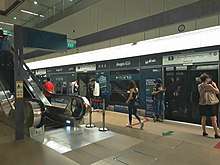Bugis MRT station
Bugis MRT station (EW12/DT14) is an underground Mass Rapid Transit (MRT) interchange station on the Downtown line and the East West line located at the boundary of Downtown Core and Rochor planning areas underneath the junction of Victoria Street, Rochor Road and North Bridge Road, Singapore. Bugis station is within close proximity of Jalan Besar MRT station on the Downtown line.
EW12 DT14
Bugis 武吉士 பூகிஸ் Bugis | ||||||||||||||||
|---|---|---|---|---|---|---|---|---|---|---|---|---|---|---|---|---|
| Rapid transit | ||||||||||||||||
 Exit B of Bugis MRT station. | ||||||||||||||||
| Location | 320 Victoria Street Singapore 188045 (EWL) 191 Rochor Road Singapore 188476 (DTL) | |||||||||||||||
| Coordinates | 1°18′01″N 103°51′22″E | |||||||||||||||
| Operated by | SMRT Trains Ltd (SMRT Corporation) (East West line) SBS Transit DTL (ComfortDelGro Corporation) (Downtown line) | |||||||||||||||
| Line(s) | ||||||||||||||||
| Platforms | 4 (2 island platforms) | |||||||||||||||
| Tracks | 4 | |||||||||||||||
| Connections | Queen Street Bus Terminal, Taxi | |||||||||||||||
| Construction | ||||||||||||||||
| Structure type | Underground | |||||||||||||||
| Platform levels | 2 | |||||||||||||||
| Parking | Yes (Bugis Junction, Bugis+) | |||||||||||||||
| Bicycle facilities | Yes | |||||||||||||||
| Disabled access | Yes | |||||||||||||||
| Other information | ||||||||||||||||
| Station code | EW12 DT14 | |||||||||||||||
| History | ||||||||||||||||
| Opened | 4 November 1989 (East West line) 22 December 2013 (Downtown line) | |||||||||||||||
| Electrified | Yes | |||||||||||||||
| Previous names | Rochore, Victoria | |||||||||||||||
| Services | ||||||||||||||||
| ||||||||||||||||
| Location | ||||||||||||||||
 | ||||||||||||||||
The station is within walking distance to Queen Street Bus Terminal, where cross-border bus and taxi services are offered.
History

Bugis MRT station was originally named Victoria and was renamed to Bugis in 1985.[1]
Construction began on 12 December that year, and the contract was awarded to Nishimatsu-Lum Chang Joint Venture.[2] The contract for the construction and completion of Bugis station and its associated tunnels was awarded to Soletanche Bachy – Koh Brothers Joint Venture for approximately S$582 million in November 2008. To facilitate the construction of the station, the Rochor Road was realigned, and the former DHL Balloon and the New 7th Storey Hotel was demolished.[3]
On 18 July 2012, two Chinese workers died after a temporary scaffolding, about 4 metres (13 ft) high, used for the construction of the new Downtown line Bugis station subway link roof slab gave way. The incident happened at about 6.50 am. The eight other injured workers who were working on top of the structure, were sent to the nearby Raffles Hospital before rescuers arrived. They had minor injuries and five of them have since been discharged. Of the remaining three workers who were hospitalised, one suffered from abdominal and chest injuries, while another suffered a back injury and the last had a finger injury. Seven of the injured are from Bangladesh while the eighth is from China. The Ministry of Manpower (MOM) has ordered all construction work to stop, while the Building and Construction Authority (BCA) has revoked the construction permit for the site while investigations are underway. MOM said that based on preliminary information gathered, workers were pouring concrete, also known as the casting process, into the formwork when the structure supporting the formwork collapsed. The formwork, located between the new and old sections of the station, was part of the structure being built to form the underground linkway, which is about three to four metres deep. The area affected is localised, measuring about five metres by 10 metres and the entire station is about 7,500 square metres. The Land Transport Authority said the station structure is substantially complete and structurally sound, and that the incident posed no risk to surrounding developments and the public.[4][5][6]
QR code shopping wall
Similar to the shopping wall at Seolleung station in the Seoul Metropolitan Subway in Seoul, South Korea, this is an interactive media launched on 7 December 2011 by SMRT in partnership with Cold Storage to enhance the commuters' travelling experience. Using a camera phone with QR code reader installed, one can purchase the items displayed on the media by simply flashing their camera phones on the items and the items would be delivered to them upon payment through the various credit cards.[7][8] Bugis, alongside Boon Lay, was the first to have such media installed.
Art in Transit
"Ephemeral" by Patrick Chua is an artwork attempting to make different experiences of commuters passing by the artwork in their daily journey.[9] It is meant to engage commuters in their moments.[10]
Nearby points of interest
- Malay Heritage Centre
- Masjid Sultan
- Bugis Street
- Queen Street Bus Terminal
References
- "MRT stations getting local touch". The Business Times. 28 November 1986. p. 2.
- Nishimatsu awarded joint venture for the construction of Bugis and Lavender stations
- New DTL Station at Bugis
- "Two dead, eight injured at MRT construction site". Channel NewsAsia. 18 July 2012.
- "Two bodies recovered from MRT work site". Channel NewsAsia. 18 July 2012.
- "MRT worksite accident: why scaffolding collapsed". Channel NewsAsia. 18 July 2012.
- Shop for turkey at train stations
- Virtual shopping at some SMRT train stations from Dec 7 Archived 7 January 2012 at the Wayback Machine
- "Downtown Line 1: Art-In-Transit" (PDF). Land Transport Authority. Retrieved 16 October 2013.
- "Bugis MRT station". SGTrains. Archived from the original on 13 June 2015.
External links
| Wikimedia Commons has media related to Bugis MRT Station. |